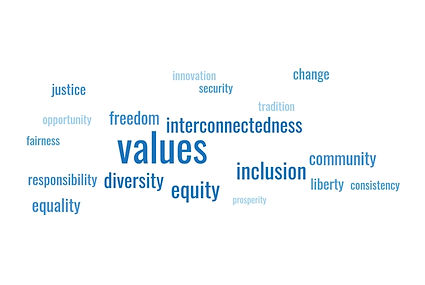1.5
The Role of Values in Collaborative Discussion
Submitted by Jack Byrd Jr.
This activity encourages participants to reflect upon and identify their personal values and to explore the role that values play in group discussions.
Learning Goals
Identify different kinds of values that are commonly embedded in a discussion.
Better understand how personal values can inform contributions in discussions.
Instructions
Set Up: Prepare for the Activity
Organize participants into small groups (5-6 ppl).
Begin by introducing the learning goals of this activity.
Step One: Craft Three Individual Value Statements (10 min)
Offer a few minutes for each participant to quietly craft their own value statements.
Share the following prompts:
What values are most important to you as a person? For example, maybe it is self-sufficiency, environmental sustainability, or justice. Write down your top values.
Take your top three values and craft value statements. For example, “I value personal responsibility. I believe that I, alone, am responsible for my actions.”
Step Two: Share Value Statements (10 min)
Within small groups, ask participants to share their value statements with at least one other person. Discussion partners can ask questions about value statements but they should not make comments or share judgments. For example, discussion partners might ask:
Where does this value come from? Was it taught to you or did you learn it some other way?
Can you share with me a time when you acted on this value?
Step Three: Practice Listening for Values in Discussions (30 min)
Craft a discussion prompt that is relevant for your group, or select one from the list of What IF… Scenarios.
In small groups, encourage participants to engage in honest discussion for about ten minutes. Allow enough time for everyone in the group to respond to the prompt.
Ask each group to pause the discussion and take a step back. Instruct participants to not worry about who was most convincing. Instead, as a group, ask them to identify which values informed their opinions. Prompts:
Which values informed the perspectives of people in your group?
How might someone else, not present in your group, respond to the prompt? What values would be informing their opinion?
Step Four: Debrief as a Full Group (10 min)
Discuss:
How does shifting the focus on values change the way you engage with others in discussion?
Which values seem most common and which seem to be outliers or less common? What does this tell us about our group?
TIME
60
min
MODULE
Introduction to Collaborative Discussion

This activity can be completed by any discussion group.

This activity can be used to build trust and interpersonal connection.

This activity can be used to support facilitation skills. See Sample Facilitation Certificate Program Design to illustrate sample sequencing.

This activity is suitable for professional or more formal learning environments.
Tell us what you think. Rate and review this activity:
Have any helpful suggestions or modifications for this activity?
Share them in the comments below!
0 Comments
YD
December 3, 2022 at 2:39:23 AM
Activity 5.4 uses the fun method of role playing and builds on other activities to help participants develop questions and practice gathering information to collaborate effectively with communities as partners. This activity involves working together in small groups and as a large group. It also includes multiple additional resources for participants to continue learning methods and skills to build community partnerships.
YD
December 3, 2022 at 2:39:00 AM
Activity 1.8 provides a very useful survey to gather information on and help support participants' different discussion styles and needs, exploring various areas like preferences for group size, ways of participating in discussions, any fears relating to discussions, etc.
YD
December 3, 2022 at 2:34:46 AM
Activity 5.8 further explores direct democracy by proposing the idea of "legislative juries" to improve the current initiative process through collaboration and deliberation. This activity uses role playing to have participants practice deliberation as part of a mock legislative jury to craft ballot initiatives on a given issue.
YD
December 3, 2022 at 2:27:35 AM
Activity 5.7 uses a fun and tactile activity like building LEGOs to explore the effects of coming together to colloborate and discuss, while also participating together in another physical activity.
YD
December 3, 2022 at 2:22:49 AM
Activity 5.6 uses memes and futuristic zombie scenarios to develop ways to change people's minds, while exploring various aspects of the methods used to change minds, like assumptions behind ideas, sticking to the facts versus stretching the truth, appealing to emotions etc.
YD
December 3, 2022 at 2:16:44 AM
Activity 5.5 uses a fun and visual/craft activity to help participants explore the many different types of knowledge, how they are valued, and the role/importance of each type of knowledge in their own lives.
YD
December 3, 2022 at 2:11:54 AM
Activity 5.3 gives participants to use writing, drawing, and/or speaking to share and discuss the various communities they belong to and/or feel excluded from, the various aspects that define community, as well as the practices of inclusion or exclusion and power distribution in these communities.
YD
December 3, 2022 at 2:07:26 AM
Activity 5.2 introduces four categories of stakeholders and multiple prompts to help participants work together in small and large groups to create comprehensive list of stakeholders, including those who are marginalized or not as obvious, for a given issue.
YD
December 3, 2022 at 2:04:00 AM
Activity 5.1 uses gamification by having participants play the Civics Topics Sweet Sixteen Competition to identify their issues they are passionate about both as individuals and as a group.
YD
December 3, 2022 at 2:01:34 AM
Activity 4.9 uses both lighthearted and serious characters, topics, and dialogue to help participants practice viewing an issue from the perspective of multiple people/characters and explain their thought processes and rationale for the choices they think these people will make in a given situation.
_edited.png)





